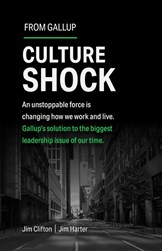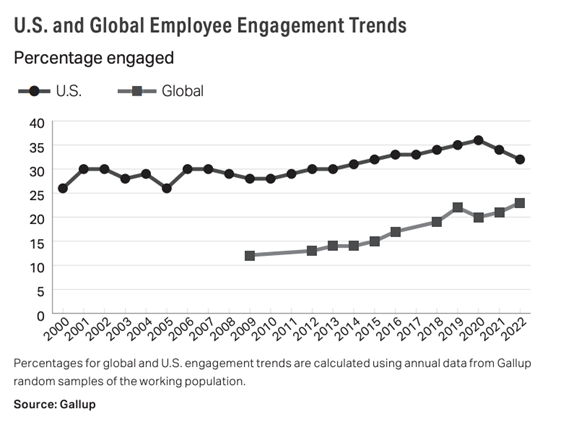An Excerpt from Culture Shock
June 13, 2023
The COVID-19 pandemic caused an awakening that shocked the world — a structural change in how and where people work and live. One thing we now know for certain: Nothing is going back to normal.
 Leaders continue to wrestle with the issue of how to bring employees back to the office. But the far greater issue is deteriorating customer relationships, which is already happening. Simply put, your employees and your customers know each other. Many are best friends. How will you maintain your customers’ commitment when you’re struggling to create a culture of dedicated employees who build and strengthen relationships with those customers?
Leaders continue to wrestle with the issue of how to bring employees back to the office. But the far greater issue is deteriorating customer relationships, which is already happening. Simply put, your employees and your customers know each other. Many are best friends. How will you maintain your customers’ commitment when you’re struggling to create a culture of dedicated employees who build and strengthen relationships with those customers?
The COVID-19 pandemic caused an awakening that shocked the world—a structural change in how and where people work and live. One thing we now know for certain: Nothing is going back to normal. Culture Shock offers a solution that outlines a better world of work and life—one with far higher productivity, greater customer retention and better wellbeing. It’s Gallup’s solution to the biggest leadership issue of our time.
To get you started, the publisher has shared a chapter on employee engagement with us.
◊◊◊◊◊
CHAPTER 14
In Decline: Employee Engagement.
Strong measures of employee engagement include elements that improve work life and predict business outcomes—notably, customer retention, but also productivity, employee retention, safety and profitability, according to Gallup’s meta-analytics of 112,312 business units and teams in 96 countries.
We found that engaged employees:
- are 2x as likely to be thriving in their lives
- can see opportunities for growth and development
- put in extra effort to create exceptional customer value
- feel connected to the mission and purpose of the organization
- have coworkers they collaborate with
- are more resilient during hard times
So how are the world’s organizations doing since the pandemic on engaging their employees and building a workforce that can create exceptional customer value? Not well.
After trending up for a decade starting at 12% in 2009, employee engagement globally slipped from 22% in 2019 to 20% in 2020 and reached a high of 23% in 2022. Gallup’s annual State of the Global Workplace study reports variance in the percentage of engaged employees across regions and countries around the world—with a high of 32% in the U.S. and a low of only 14% in Europe. Gallup estimates that low employee engagement costs the global economy $7.8 trillion in lost productivity—a staggering 11% of global GDP.
Even the country with the most engaged employees, the U.S., saw its first annual decline in a decade. Starting at 26% in 2000, the percentage of engaged employees in the U.S. did not have much movement through 2010 and reached a high of 36% in 2020—then dropped to 34% in 2021. This downward pattern continued into 2022, when only 32% of U.S. employees were engaged.

Some of the reasons for the recent declines in engagement are obvious. The pandemic disrupted how people work, and leaders and managers had to anticipate and respond to pandemic spikes.
Trying to blend work and life—managers and employees trying to manage their lives at the same time they were managing work—has also been disruptive. Burnout among managers rose significantly.
Uncertainty contributes to disengagement
Gallup saw the most decline in agreement with these engagement (Q12) items from early 2021 to 2022:
- I know what is expected of me at work.
- At work, I have the opportunity to do what I do best every day.
- I have the materials and equipment I need to do my work right.
- The mission or purpose of my company makes me feel my job is important.
We also found an eight-point decrease in the percentage of employees who were extremely satisfied with their organization as a place to work.
Healthcare workers had the greatest drop in engagement (nine points) from early 2021 to early 2022. Managers’ engagement fell seven points from early to late 2021, and as noted above, manager burnout spiked.
Since before the pandemic, declining engagement was evident across employees who were exclusively remote, hybrid and exclusively on-site — but the decline was greatest for exclusively remote employees.
Why engagement is even more important now
With the increases in hybrid and fully remote work, many have asked Gallup if the same employee engagement elements are relevant. Gallup studied how each of the 12 engagement items predict outcomes such as job hunting, likelihood to recommend and burnout.
Gallup compared the impact of employee engagement before the pandemic to its impact in 2022, after the workplace shifted. Two distinct patterns emerged: Engagement items related to role clarity (knowing what is expected and having the opportunity to do what you do best) and coworker relationships (fellow associates are committed to doing quality work and having a best friend at work) mattered even more than before the pandemic.
To illustrate, before the pandemic, those with a best friend at work were 50% more likely than others to strongly recommend their company as a place to work and 13% less likely to leave their organization. In 2022, those with a best friend at work were twice as likely to strongly recommend their company and 24% less likely to leave their organization.
Gallup’s time-tested 12 employee engagement question items represent basic human needs at work. But as times change, work priorities change — in this case, role clarity and workplace relationships.
Employee engagement is foundational to improving the wellbeing, resilience and customer focus of a workforce because it includes elements of communication, development and collaboration. These elements set the stage for trust and overall wellbeing.
Excerpted from Culture Shock: An Unstoppable Force Has Changed How We Work and Live. Gallup's Solution to the Biggest Leadership Issue of Our Time by Jim Clifton & Jim Harter.
Copyright © 2023 Gallup, Inc.
All rights reserved.


